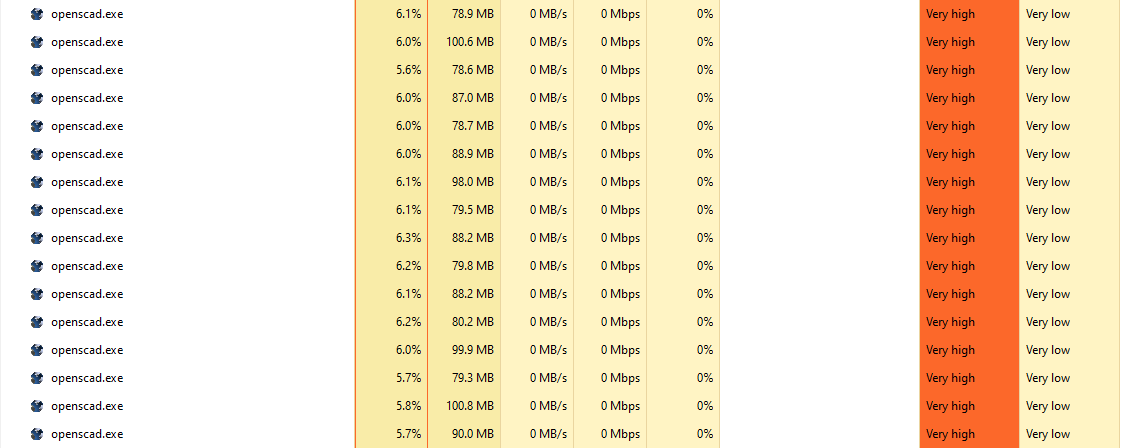While rendering several, highly complex modules in OpenSCAD, I found the limit of one CPU thread to be not enough.
I wrote something in bash that makes use of & and decided to take it further to do it with organised threading and queueing in Python.
This code does not make single operations faster, it only parralellises single operations and runs them simultaneously. If you've got a single model being rendered, it will not make anything faster.
- This script loads the
render_config.yamlfile that has config and a list of names of modules and output formats - For each entry in the
modelslist in the config the code generates a temporary scad file - For each temporary scad file it runs a subprocess thread that renders and pipes the output to a file in the
outputdirectory - Then it deletes the temporary scad files
- Finally the script reports the runtime.
These instructions assume you have a single OpenSCAD file or a single entrypoint. There are a few things you need to do to use this in your projects:
- create
render_config.yamlin the same folder as your entrypoint OpenSCAD using the example code block - Use the put the workspace
- Put the renderer.py into your
$PATHor refer to it's full path
Note: The suffix value can be anything understandable by OpenSCAD.
Once you have all this above you just need to execute the renderer.py script while you're in your project directory.
Only the models list is necessary in here
scad_file: mycoolfile.scad
#openscad_path: "/Applications/OpenSCAD.app/Contents/MacOS/OpenSCAD" # optional on mac/windows
#threads: 16 # defaults to all cores
#quality: 95 # default 95
models:
- module: "easy_render_5_for_dxf" # name of the openscad function to run
suffix: "dxf" # Suffix is needed if you don't want an STL
- module: "easy_render_4" # had no suffix so defaults to STL/** working output code **/
if (is_undef(batch_rendering)) {
$fn = 40; // the FN for your prototyping
// your prototype code
}
// your module code here
The base code tests how fast this can process using 4 threads, execute the code with no changes to see how well it works with 4 threads.
Change the number_of_threads variable in the yaml file to see how well it does with 1,8,16,42,200 threads and, provided your OS is happy to do so and doesn't run out of resources, it will render simultaneously and thus make use of all those CPU cores you're not using.
Benchmarked on a Windows 11 machine with:
- Intel Core i7 10700KF (8 core/16 thread) (3.8 GHz base, 4.8ghz boost)
- 32GB Ram
- PCI SSD's
- Python 3.9.7
- RTX3080
- OpenSCAD version 2021.05.26
- Not much else going on
I've configured a pretty brutal test, possibly introducing a variation thats way too high because the $fn = 90 increases the amount of operations dramatically, still why not test a boat with a storm?
In my default file, I've disabled rendering jobs for the really complex modules because they weren't demonstrating anything new, feel free to enable them.
Threaded stats here:
| Threads | Render time | Notes |
|---|---|---|
| 1 | 4:54 | Comparable to the GUI - computer didn't notice |
| 2 | 2:35 | again Comparable to the GUI - computer didn't notice |
| 8 | 1:17 | the total time for all 16 models was 1 second longer than the longest build |
As to be expected; my CPU does a better job at rendering 8 things at a time than it would trying to do 1 things at a time.
This is what it looks like:
If you manage to render more models at once than you have threads, the CPU will start scheduling hard, so more threads than you have means less productivity.
By default the script will use a thread per registered CPU - which is one per hyper-thread - up until it runs out of models to render.
- Python 3.6+
- OpenSCAD
- Windows/MacOS/Linux environment
This was built with Python3.6 installed using pyenv, I'm no python master, this is not tricky.
Dan Kirshner.
In the interests of making hard-to-render workloads I've used the thread module file from openscad-threads its fantastic!
I've modified it so it doesn't limit the $fn variable because while this is very useful in normal use, I don't want to reduce the load in this case.
/*
* — — — — — — — — — — — — — — — — — — — — — — — — — — — — — — — — —
* “THE BEER-WARE LICENSE” (Revision 42):
* <spidey> wrote this file. As long as you retain this
* notice you can do whatever you want with this stuff. If we meet
* some day, and you think this stuff is worth it, you can buy me
* a beer in return.
* — — — — — — — — — — — — — — — — — — — — — — — — — — — — — — — — —
* Amendment 1: The author(s) of this code accept absolutely no
* liability for any damage or general bad things that may come as
* part of its use. Any use of this software is deemed an agreement
* to absolve the author(s) of any liability, culpability,
* durability and any other “(*)ability” (good or bad).
*/
